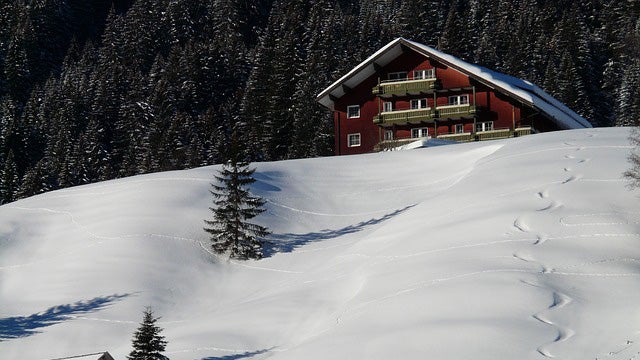Maybe we’re assuming too much, but we’re going to guess that your perfect day includes some of the following: a hard workout, a beautiful place, enough of an adrenaline rush to make things exciting, good food, friend, a fire, and not having to answer emails or put real pants on. Correct? Then you’re probably going to enjoy a hut trip.
How are you getting there?
Make sure that you’re comfortable on you gear for a long slog with a heavy pack. Hut trips can be a good intro to backcountry travel because they’re often on low-angle, heavily traveled routes, but you’ll be skiing with more weight than you’re used to, on gear that might be unwieldy. Get familiar with your gear, and how it works on the uphill and the down, before your trip, so you won’t be out of your element when you’re 10 miles from the trailhead. “Skiers should be able to rip their skins, change their clothes, lube their lips and fuel up their bodies in under 5 minutes,” says Silverton, Colorado-based guide Sheldon Kerr. “A well-organized pack and a few sessions peeling and applying skins will help with this,”
What are you bringing?
In addition to the ski gear and avi gear you’d bring on any ski tour, pack extra layers. Temps can change fast and it can be hard to warm up once you’re cold. Once you’re at the hut, long underwear as outerwear is totally acceptable, but don’t forget to bring something to wear on your feet—down booties are ideal—so you’re not stuck clomping around in your ski boot liners. As far as camping gear goes, check your destination before you go, but huts often come stocked with cooking gear, and bedding supplies, which will lighten your load.
What is the snow like?
You’re probably heading into a zone where you haven’t been skiing recently. To get a sense of the snowpack, monitor the local avalanche forecast, which you can find at avalanche.org, before you go. You should have avalanche education before you head out. “If skiers do not have avalanche training they should not enter avalanche terrain,” Kerr says. The trick, then, is to be able to recognize avalanche terrain in order to avoid it. Bring a clinometer and stay on slopes which are 20 degrees or less. Don’t travel underneath steep terrain.” If that limits your options, take an AIARE or AAA level 1 avalanche class, or go out with a guide.
Who are you going with?
The people in your party are going to play a big role in how your trip turns out. Group dynamics are a serious factor avalanche safety and risk, and, according to UIAGM guide Margaret Wheeler, those dynamics are set in the first two minutes of a trip. So make sure you’re comfortable with the group, you feel like your voice is heard, and everyone is on the same page in terms of communication and the risks they’re willing to take. Not to mention, if you’re cooped up in a hut with the same people all weekend, you probably want to get along with them.
What are you going to eat?
Probably bacon, and boxed wine. The biggest benefit of a hut trip is that you’re probably not trying to be fast and light, and you’re not hauling in a structure to sleep in. That means that you can burn some packweight on fancy food. Break eggs into a water bottle before you leave the house for breakfast omelets, pack hearty veggies like sweet potatoes for dinner staples, and remember that snacks are crucial. It’s cold and you’re going to be working hard, so calorie dense treats like cheese, nut butters, and pepperoni are good.
What are you going to do?
Skiing lines right outside your door is nice, but it’s often just the icing on the cake. At the hut, play Bananagrams, build a kicker, get in that sauna, read, drink whiskey, melt snow for water, talk to people, do not look at your cell phone.
A few of our favorites:
An hour west of Bozeman in the Tobacco Root Range, the Bell Lake Yurt gives you access to every kind of skiing you could want, from mellow meadow skipping runs to the couloirs of Branham Peak, to bowls in Bell Lake Cirque.
10th Mountain hut trips are a rite of passage in Colorado’s backcountry community. The 30 huts in the system are well loved and well maintained, some of them even have saunas and running water. Their access varies, from Francie’s Cabin, just 2 miles from the trailhead outside of Breckenridge to the Friends Hut, which is 10.5 miles from the nearest road.
Oregon’s Wallows hold an untold number of ski lines, and you can access a lot of them on 3-5 day “hosted” trips from the Wallowa Huts.


